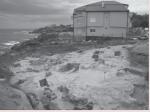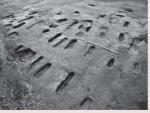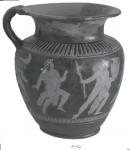Summary (English)
EXPLORATIONS IN APOLLONIA (Krastina Panaiotova – kpanayotova@abv.bg, Margarit Damyanov) Twenty-eight graves cut out into the limestone bedrock were explored. The burial pits were rectangular, 2 – 2.10 m long, 65 – 75 cm wide and down to 1 m deep. There were rectangular holes in the corners of six burial pits, probably to accommodate legs of funerary beds, and nine burial pits were covered with stone slabs. The funerary ritual was inhumation with head to the east or the northeast (the head of the deceased in Grave No. 25 was directed to the north and the head of the deceased in Grave No. 18 was directed to the west). The deceased were laid supine. The bottom of Grave No. 17 was covered with ash and embers, which covered the skeleton. The grave goods included lekythoi (found in 22 graves), alabastra (found in two graves), cups, dishes, jugs, oinochoai, a krater, amphorae, ceramic lamps, bronze strigils, mirrors, a bronze fibula and a silver one of the Thracian Type (found in Grave No. 22). Seven ritual hearths were explored, containing black-gloss and local dishes, ichthyai, pots, a lekane, terracotta fish grills and a lamp. The graves dated to 450 – 350 BC, judging from the red-figure and black-gloss vessels and the amphorae from Chios, Heraclea Pontica (including stamped amphorae from the 380s and the 370s BC), Thasos, Lesbos and amphorae of the Murighiol Type. Trenches of the 2nd – 4th centuries AD were documented that were related to agricultural activities, probably vineyards. Twelve more graves were explored. Grave No. 2 was a cremation and the ashes were placed in a ceramic urn. The other burials were inhumations in pits dug out into the clay bedrock. The deceased were adults, while a small child was buried in Grave No. 8. They were laid supine with heads to the east. The grave goods included lekythoi (found in six graves), an alabastron, a red-figure jug of 425 – 400 BC, black-gloss vessels, pots, a dish, an amphora, two bronze and two iron strigils, and a bronze fibula. The graves dated to the second half of the 5th and the beginning of the 4th centuries BC.
- Krastina Panaiotova - Archaeological Institute with Museum
- Margarit Damyanov - Archaeological Institute with Museum
Director
Team
Research Body
- Archaeological Institute with Museum






![Download [PDF]](/excavation/skins/fasti/images/results/download_sml.png)

